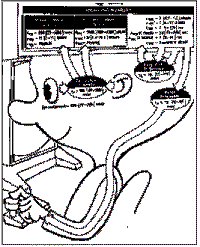 GOMS is a theory of the cognitive skills involved in human-computer tasks. It is based upon an information processing framework that assumes a number of different stages or types of memory (e.g., sensory store, working memory, LTM) with separate perceptual, motor, and cognitive processing. All cognitive activities are interpreted in terms of searching a problem space, the fundamental premise of GPS and Newell’s Soar theory .
GOMS is a theory of the cognitive skills involved in human-computer tasks. It is based upon an information processing framework that assumes a number of different stages or types of memory (e.g., sensory store, working memory, LTM) with separate perceptual, motor, and cognitive processing. All cognitive activities are interpreted in terms of searching a problem space, the fundamental premise of GPS and Newell’s Soar theory .
According to the GOMS model, cognitive structure consists of four components: (1) a set of goals, (2) a set of operators, (3) a set of methods for achieving the goals, and (4) a set of selection rules for chosing among competing methods. For a given task , a particular GOMS structure can be constructed and used to predict the time required to complete the task. In addition, the model can be used to identify and predict the effects of errors on task performance. Error recovery is assumed to involve the same four components as correct actions.
Application
The primary application of the GOMS model is to text editing tasks, although it has also been applied to a wide range of computer tasks (see Olson & Olson, 1991). GOMS is intended as system design methodology that allows computer designers to test user interface designs (e.g., Kieras, 1985; Oray, John & Atwood, 1993). Gong & Elkerton (1990) report the use of the GOMS model to develop computer documentation using the minimalist model of Carroll .
Example
Here is the outline of the GOMS model for a line editor (Card, Moran, & Newell, 1983, chapter 5):
Goal: Edit-Manuscript
Goal: Edit-Unit-Task
Goal: Acquire-Unit-Task
Get-Next-Page
Get-Next-Task
Goal: Execute-Unit-Task
Goal: Locate-Line
[select: Use-QS-Method/Use-LF-Method]
Goal: Modify-Text
[select: Use-S-Command/Use-M-Command]
Verify-Edit
An example of a goal generated to correct a mistake is:
Goal: Correct (BadCharacter)
Look-At-Display
Compare
Type (Control-A)
Type (CorrectCharacter)
Principles
- To improve the performance of a cognitive skill, eliminate unnecessary operators from the method used to do the task (or use other methods).
- The operators involved in cognitive skills are highly specific to the methods used for a given task.
- Task performance can be improved by providing a set of error-recovery methods.
References
- Card, S., Moran, T. & Newell, A. (1983). The Psychology of Human-Computer Interaction. Hillsdale , NJ: Erlbaum.
- Gong, R. & Elkerton, J. (1990). Designing minimal documentation using the GOMS model: A usability evaluation of an engineering approach. CHI 90 Proceedings. New York: Association for Computing Machinery.
- Kieras, D.E. (1985). Towards a practical GOMS model methodology for user interface design. In M. Helander (Ed.), Handbook of Human-Computer Interaction. Amsterdam: Elsevier/North Holland.
- Olson, J.R. & Olson, G.M. (1991). The growth of cognitive modeling in human computer interaction since GOMS. Human Computer Interaction, 6, 21-30.
- Oray, W.D., John, B., & Atwood, M. (1993). Project Ernestine: Validating GOMS for predicting and explaining real-world task performance. Human Computer Interaction, 8. 112-120.
Related Websites
For more about GOMS, see: http://www.eecs.umich.edu/~kieras/goms.html